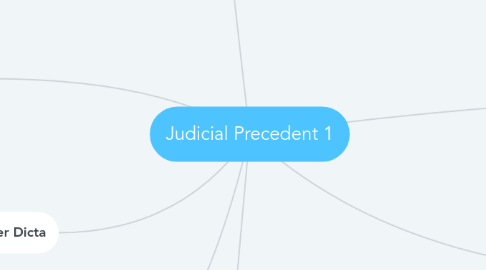
1. Stare Decisis
1.1. “to stand by things decided.”
2. Case Law
2.1. Order of courts
2.1.1. Supreme Court
2.1.1.1. Appeal Court (Criminal)
2.1.1.1.1. Crown Court
2.1.1.1.2. will not follow its own decisions where to do so would cause injustice
2.1.1.2. Appeal Court (Civil)
2.1.1.2.1. High Court
2.1.1.2.2. Bound by previous decisions
2.1.1.3. Practice Statement 1966
2.1.1.3.1. Lord Gardiner: ‘Their Lordships regard the use of precedent as an indispensable foundation upon which to decide what is the law and its application to individual cases. It provides at least some degree of certainty upon which individuals can rely in the conduct of their affairs, as well as a basis for orderly development of legal rules. Their Lordships nevertheless recognise that too rigid adherence to precedent may lead to injustice in a particular case and also unduly restrict the proper development of the law. They propose therefore, to modify their present practice and, while treating former decisions of this house as normally binding, to depart from a previous decision when it appears right to do so.’
2.1.1.3.2. Limited use, Traditionally follows Precedent
2.1.2. Privy Council
2.1.2.1. R v James and Karimi (2006) Miliangos v George Frank (Textiles) Ltd (1976)
2.1.3. Court of Justice of the European Union
2.1.3.1. Binds
3. Obiter Dicta
3.1. Words not necessary for the decision must be obiter.
3.1.1. "[T]here is in my opinion no justification for regarding as obiter dictum a reason given by a judge for his decision, because he has given another reason also." Lord Simonds
3.2. observation made by the judge on a legal question suggested by the case before him or her but not arising in such a manner as requiring a decision
3.3. court in a later case and not the judge in the original case determine
4. Ratio Decidendi
4.1. binding on later courts
5. Judges make law
5.1. Why?
5.1.1. Social change might demand law reform
5.1.2. Some areas are suitable for common law development where others are not
5.1.2.1. For same reasons, courts should avoid developing law in areas under Parliament examination
5.1.2.1.1. R (on the application of Nicklinson) v Ministry of Justice (2014) – assisted voluntary euthanasia
5.1.3. Lord Devlin (1979) – judges should engage in activist law-making (where there is a consensus) – and should avoid dynamic law-making, which should be left to Parliament
5.1.3.1. Professor Burrows: ‘…it is an abdication of judicial responsibility for judges, at least in the law of obligations, to decline to develop the common law on the grounds that legislation is more appropriate. Even if a statutory solution would be better, no-one can predict whether legislation will, or will not, be passed. It is therefore preferable for judges to proceed as they think fit, whether the decision be in favour or against a development, knowing that the Legislature is free to impose a statutory solution if the common law position is thought unsatisfactory or incomplete.’
5.1.3.2. Lee, J. : ‘Certainty does not necessarily require that rules never change: in fact a change in precedent may serve to clarify the law and rescue it from a state of uncertainty.’
5.1.4. Upholding parliamentary opinion
5.1.4.1. judge is not delegated to pronounce new law, but maintain and expound the old one
5.2. Blackstone's declaratory theory
5.2.1. judge is not delegated to pronounce new law, but maintain and expound the old one
5.3. Examples
5.3.1. R v Dica (2004)
5.3.1.1. Secret HIV
5.3.2. DPP v Jones (1999)
5.3.2.1. Protest on private or public land
5.3.3. Gillick v West Norfolk and Wisbech Area Health Authority (1985)
5.3.4. Donoghue v Stevenson (1932)
5.3.5. R v R (1991)

